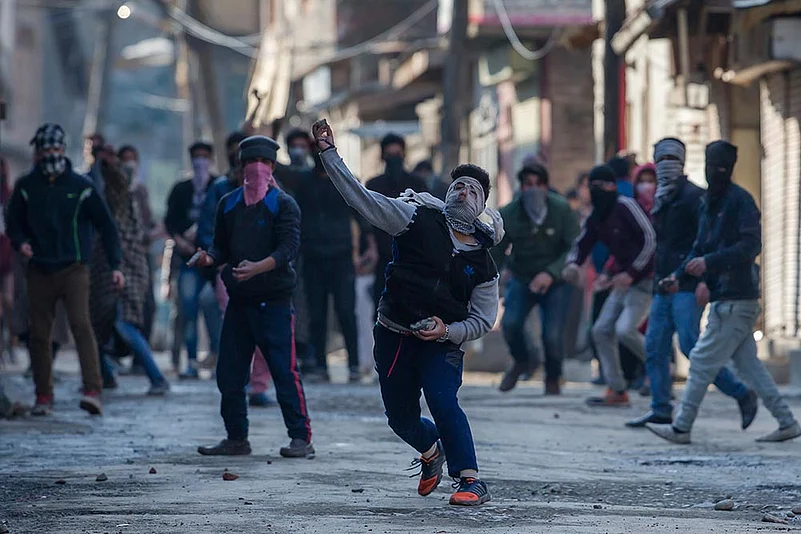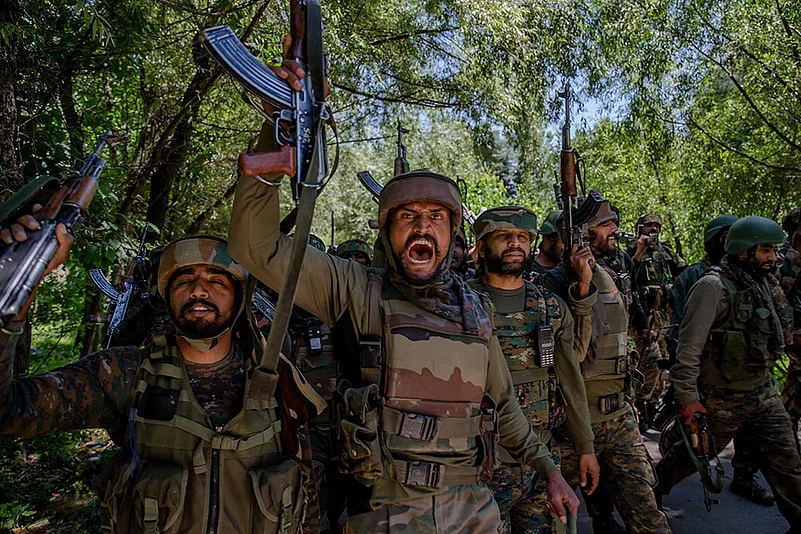The image of political leaders throwing up doves in an open sky, though a bit of a cliche, continues to have a certain salience and meaning as a gesture: it is a signalling for peace, just as a white flag is one for surrender. Prime Minister Narendra Modi may not yet have thrown up a dove but his Independence Day message from the Red Fort ramparts, emphatically expressing his desire to reach out to Kashmiris, now has a real corollary: in his surprise choice of Dineshwar Sharma as the interlocutor for Kashmir. With the fear of violence having ebbed after a couple of fraught seasons and a modicum of calm returning, the time seems ripe for another spell of dialogue.
Sharma is an atypical man for someone from the heart of the intelligence establishment—he served two years as IB chief (2015-17). Not one of the prime-time screamers, the soft-spoken Sharma has made conciliatory remarks about stone-pelters and spoken of the universal desire to see peace in Kashmir. Perhaps precisely because of his low profile, he has managed to evoke interest in the restive Valley and beyond, forcing people to parse Modi’s speech to ascertain both the sincerity and the durability of New Delhi’s latest peace initiative.

Kashmiri youths throw stones at security forces in Srinagar
“The Kashmir problem cannot be resolved through goli ya gaali (bullets or abuses). It has to be resolved by embracing all Kashmiris,” Modi had said in his August 15 speech, talking of a wish to reach out to the widest possible number of people in Jammu and Kashmir, especially the youth who seem totally disillusioned with the present situation. Framing that speech was the context of a changed narrative in the Valley, where a year of severe civilian unrest—and a matchingly tough ‘area domination’ approach from the security forces—had ended with the new presence of radicalised Islamist militant ideologues entering discussions and media portrayals.
For long, the image of a ‘tough’ leader, carefully crafted over the years, has served Modi well. The persona of an able administrator with a ‘no-nonsense’ attitude towards security issues—as much as towards the pursuit of growth—has been his prime calling card. With a penchant for out-of-the-box solutions to break the status quo in politics, economics and diplomacy, Modi has also been one of the most disruptive leaders the country has known. Demonetisation and GST, though many hotly debate their efficacy, were conceived as game-changers. His Kashmir gambit too is of a piece with that desire to paint on a large canvas—and has hence caught the nation’s attention and perhaps also of people beyond India’s borders.

Indian soldiers after a gun-battle with militants in Dialgam, south of Srinagar
One of the most interesting aspects of this move is, of course, the chosen man for the job. Though Sharma’s appointment was announced by Union home minister Rajnath Singh, who himself spent some days in September in the Valley talking to a large number of people, the former IB chief’s gentle, unassuming persona contrasts sharply with that of the high-profile prime minister, prompting many to describe him as “Modi’s dove”.
Discussions are naturally on in policy and diplomatic circles to understand the full import of the government’s move—its intent, design and timing. But it does come as part of a series of efforts from New Delhi to craft an entente. The PM’s own trip in April to inaugurate the Banihal tunnel signalled his degree of investment. Before that, in September 2016, Rajnath had led an all-party parliamentary delegation—which included Opposition figures like Sharad Yadav and Sitaram Yechury—that attempted to open up the space for dialogue, including with the Hurriyat (which did not respond, since it was at the height of the unrest). This September, Rajnath again set the ball rolling for a thaw with a visit to the state. The interlocutor’s appointment comes in this backdrop.
It is too early to judge how effective Sharma will be. The former IB chief comes with wide experience in Kashmir and has intimate knowledge of its militant and hardline landscape. The government’s critics look askance at the move, some outrightly questioning its timing and motives. But others are willing to welcome it. “This is the best thing that has happened in the last two years,” says former RAW chief A.S. Dulat, who had also served as IB special director and as an advisor for Kashmir in the Vajpayee government.
“Trust is an important thing in such talks and Sharma is the best guy they have got for this job,” he adds. Building trust will call for some diligence and care. After two seasons of mass unrest, the more hardline sections have little room for manoeuvre. The Hurriyat Conference leaders, for instance, have rejected the latest effort for the time being—and they are the only formal political expression of the separatist sentiment. It’s vital that they be engaged, says Dulat, to ensure a wider participation in the government’s outreach programme.
K.C. Tyagi, JD(U) MP, feels the effort could have come even earlier but still sees it as a welcome step. “This is an opportunity, even though much delayed. It should be grabbed by all sections of the society,” he says. Expressing concern over the drift in the Valley, Tyagi points out that the Kashmiri youth, who earlier would not look beyond Pakistan, are today drawing inspiration from ISIS and developments in Syria, Iraq and Palestine. Every effort must be made to engage with them and win them back to the mainstream, he says.
Shiv Sena’s Sanjay Raut expressed surprise at the government’s move as he recalls how the BJP had been pushing for a hard line when the UPA government had attempted dialogue. “However, Kashmir is a sensitive issue and if the government thinks this is the best way to handle it for the unity of the country, we will support it,” says Raut.
Since Nehru, Kashmir has been an enigma and a challenge whose complexities successive prime ministers have tried to crack, but not with much success. In the words of historian Gyanesh Kudaisya, “Marked by dramatic twists and turns in the years after independence and in the decades thereafter, the Kashmir story has several parts”. He points out that when one considers the ‘integrative’ agenda of the 1950s, the region of Kashmir defies any exercise of neat labelling either in terms of success or failure.
C. Uday Bhaskar, director, Society for Policy Studies, adds to the mood of ambivalence, saying, “Kashmir always reminds me of the myth of Sisyphus. No matter how much you manage to push the rock up the mountain, it always manages to roll down.” This means, like Sisyphus, one must struggle perpetually without any hope of success—a spectre of hopeless, futile labour.
But such an outcome can hardly be acceptable to any prime minister, especially a figure like Modi. Like his predecessors, he hopes to leave a mark by completing the ‘integrative’ agenda, an exercise begun at the time of independence, but still not consummated. Bhaskar, though supportive of the idea of engagement, feels, “It is rather late in the day as the government in Delhi has entered the final phase of its term.” This is, however, contested by South Block officials who argue that several efforts had indeed been made by the government to engage various stakeholders in the Valley—besides Pakistan, the perennial factor in the state with its encouragement and pursuance of cross-border terrorism as a foreign policy tool.
Rather than a late realisation, officials recall, Modi had surprised everyone by starting his very tenure in 2014 with a gesture of peace—inviting then PM Nawaz Sharif to his inaugural ceremony. That momentum was only lost after a series of attacks by Pakistan-based terror groups in India (like Pathankot and Uri) and also military tension along the LoC, after which he decided to act tough on Pakistan and its proxies in the Valley.
And despite this tough policy against Pakistan and cross-LoC infiltration, captured by the surgical strikes, it’s argued that the government never lost focus on development in the state. The PM himself announced a development package of over Rs 80,000 crore, besides a variety of outreach attempts that accompanied the crackdown on mass protesters.

Union home minister Rajnath Singh paying tribute to fallen J&K policemen in Anantnag
Modi’s detractors, however, argue that it’s the failure of its ‘hardline’ and ‘muscular’ policy that has forced the government to do a course correction. To support this argument, they draw attention to the overall deterioration in the atmosphere in Kashmir in the past two years, especially after the killing of young militant commander Burhan Wani. A series of street protests had brought large numbers of stone-pelters, mostly young teenagers, to come out against security forces and New Delhi’s policies.
Officials counter that the government was never against talks with those who abjured violence and looked at solutions within the Indian Constitution. And the non-compromising stance on security that characterised its response, they add, means the present peace initiative comes from a position of strength. Earlier governments, they say, went in for talks only when violence in Kashmir was at its peak. The government’s policy against militants also led to a sharp increase in the death of Pakistan-origin terrorists (see figures in infographic) and, according to them, managed to silence and isolate anti-talks sections and bring an end to stone-pelters’ agitations. In this view, therefore, there are no compelling factors that have forced New Delhi—as suggested by some of its detractors. Only a desire for ‘consistent’ policy to have talks with the widest possible number of Kashmiris who were so far afraid to engage with the government for fear of the gun.
“Speaking from a position of strength is not such a bad thing as the hardliners know the government has not been forced to engage with them out of any compulsion,” agrees former home secretary G.K. Pillai. But he points out that the government must be sincere in its effort at addressing the genuine grievances of the people rather than going into the exercise merely as an opportunity to make a day’s headline.
In another important departure from past practices, the government has made it clear that while talks are on, it necessarily did not mean an end or suspension of security operations against terror groups. Officials argue that in the past such opportunities were used by militants to regroup and recuperate before striking back. Despite criticism from some sections, it has been stated that the government does not view it as an ‘either/or’ situation.
Sharma’s first task would be to make an on-the-ground assessment of the situation in Kashmir and seek out a variety of stakeholders, especially from among the disillusioned sections of youth, which by all indications will be a tall ask. The retired intelligence czar’s sally into peacemaking can only work if he is given room, flexibility and unstinted backing by his political masters in New Delhi. Otherwise, like many others in the past, this effort too can become a mere footnote in the history of India, for its inability to put its own house in order.
By Pranay Sharma with inputs from Bula Devi
















